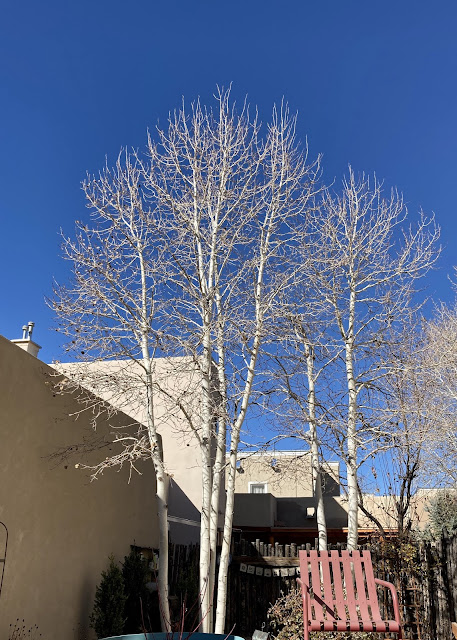Ghost Trees
At this time of year with their leaves down, the aspens look ghostly, even on a bright blue day.
Their strikingly white bark is the main feature that makes them so ornamental, but they also have gorgeous yellow foliage in fall, a full shady canopy, and a narrow upright habit that fits small courtyards. The multi-stem clumps mimic a grove, making a couple trees feel like a woodland. Almost every home in our 20 year old community has aspens, some tucked up against the house, a few in a corner, one or two featured in an open spot, some rising up over fences. Aspens everywhere.
In our tiny yard there were seven separate clumps, and five are still living: two in back by the deck and two smack up against the dining room window, leaning away from the house. Another small one grows in the alley between our house and the neighbor. Two others were taken down before we moved in. I see the stumps, though -- in this dry climate stumps do not rot.
All our immediate neighbors have at least four or five of their own aspens in their tiny spaces abutting ours, so our borrowed view over the fence is more aspens. Aspens all around. Groves of them.
But aspens are not good yard trees. For one thing, their leaves have a waxy surface that protects them from dry western air, but it means the leaves don't break down in winter. After the golden yellow show, when the leaves fall they remain crispy blackened discs that never go away. They don't disintegrate, they just pile up in the garden and all over the gravel forever and ever.
Even worse, aspens in cities don't grow well. Their natural habitat is mountain woodlands, with thick moist duff at their feet and cool temperatures, where they spread out in big cloned stands. They do not do well in hot urban places, in dry conditions or planted as specimens alone. That's not what aspens want, and many urban trees suffer. They get bug diseases, iron chlorosis and branch and trunk dieoff.
The Santa Fe Botanical Garden does not recommend planting aspens in home landscapes. With climate change, conditions are getting even worse for aspens planted in cities. Arborists make a living taking the diseased ones down.
In all the new building development going on around town, landscapers do not plant aspens any more. The large brand new development behind us is beautifully landscaped with hundreds and hundreds of trees and shrubs lining the streets and open parkways, all nicely laid out, but not a single aspen to be seen. There is a visual difference between older neighborhoods with aspen mini-groves everywhere and new homes without any.
And yet. They were planted so prolifically in the past and they have created such an iconic woodland look that it's hard to imagine our neighborhood without these trees. Our five trees look okay for now -- we water and fertilize them well.
But when they stand so white and ghostly in winter, and with their disappearance in modern landscapes, it reminds us that they are not long for the world of faux forests and mimicked woods that we have created. They will all be ghosts in time.





Comments